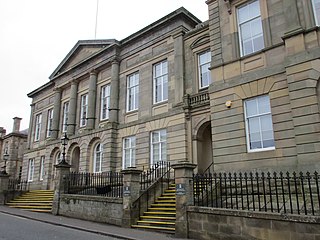
Inveraray Jail is a former prison and courthouse in Church Square, Inveraray, Argyll and Bute, Scotland. It was built in 1820 and is a Category A listed building. The prison closed in 1889 but the building remained in use as a courthouse until the mid-twentieth century, in which time it was also used for some meetings of Argyll County Council. Since 1989 it has been a museum.

Greenock Sheriff Court is a judicial building on Nelson Street in Greenock in Scotland. The structure, which continues to operate as a courthouse, is a Category B listed building.

County Buildings is a municipal structure in King Erik Street, Lerwick, Shetland, Scotland. The structure, which is used as a judicial complex, is a Category B listed building.

Campbeltown Town Hall is a municipal structure in Main Street in Campbeltown, Argyll and Bute, Scotland. The structure, which is used as a community events venue, is a Category B listed building.

Tain Tolbooth is a municipal building in the High Street, Tain, Highland, Scotland. The structure, which is used as a courthouse, is a Category A listed building.

Dumbarton Sheriff Court is a judicial structure in Church Street, Dumbarton, West Dunbartonshire, Scotland. The complex, which was the headquarters of Dunbartonshire County Council and is currently used as a courthouse, is a Category B listed building.

County Buildings is a municipal structure in Ettrick Terrace, Selkirk, Scottish Borders, Scotland. The complex, which was the headquarters of Selkirkshire County Council and was also used as a courthouse, is a Category B listed building.

County Buildings is a municipal structure in Drysdale Street, Alloa, Clackmannanshire, Scotland. The structure, which was the headquarters of Clackmannanshire County Council and is currently used as courthouse, is a Category B listed building.

Hamilton Sheriff Court is a judicial building in Almada Street, Hamilton, South Lanarkshire, Scotland. The building, which continues to serve as the local courthouse, is a Category A listed building.

Lanark Sheriff Court is a judicial building in Hope Street, Lanark, South Lanarkshire, Scotland. The building, which continues to serve as the local courthouse, is a Category B listed building.

Forfar Sheriff Court is a judicial building in Market Street, Forfar, Angus, Scotland. The building, which remains in use as a courthouse, is a Category B listed building.

Oban Sheriff Court is a judicial building on Albany Street in Oban in Scotland. The building, which remains in use as a courthouse, is a Category B listed building.

The Old Sheriff Court is a judicial building on Hope Street in Falkirk in Scotland. The building, which currently accommodates a firm of funeral directors, is a Category B listed building.

Dundee Sheriff Court is a judicial building on West Bell Street in Dundee in Scotland. The building, which operates as the main courthouse for the area, is a Category B listed building.

Kirkcaldy Sheriff Court, formerly known as County Buildings, is a judicial building on Whytescauseway in Kirkcaldy in Scotland. The building, which continues to operate a courthouse, is a Category B listed building.

Linlithgow Sheriff Court is a former judicial building on the High Street in Linlithgow in Scotland. The building, which has been converted for residential use, is a Category B listed building.

Stornoway Sheriff Court is a judicial building on Lewis Street in Stornoway in Scotland. The building, which continues to be used as a courthouse, is a Category B listed building.

Fort William Sheriff Court is a judicial building on the High Street in Fort William in Scotland. The building, which continues to be used as a courthouse, is a Category C listed building.

Lochmaddy Sheriff Court, also known as County Buildings, is a judicial building in Lochmaddy in Scotland. The building, which continues to be used as a courthouse, is a Category C listed building.

Dunoon Sheriff Court is a judicial building on George Street in Dunoon, Argyll and Bute in Scotland. The building, which continues to be used as a courthouse, is a Category C listed building.





















